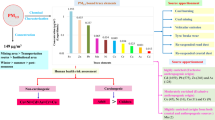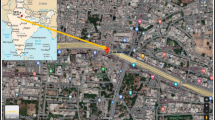Abstract
Monitoring of ambient PM10 (particulate matter which passes through a size selective impactor inlet with a 50% efficiency cut-off at 10 μm aerodynamic diameter) has been done at residential (Kasba) and industrial (Cossipore) sites of an urban region of Kolkata during November 2003 to November 2004. These sites were selected depending on the dominant anthropogenic activities. Metal constituents of atmospheric PM10 deposited on glass fibre filter paper were estimated using Inductively Coupled Plasma Atomic Emission Spectrometer (ICP-AES). Chromium (Cr), zinc (Zn), lead (Pb), cadmium (Cd), nickel (Ni), manganese (Mn) and iron (Fe) are the seven toxic trace metals quantified from the measured PM10 concentrations. The 24 h average concentrations of Cr, Zn, Pb, Cd, Ni, Mn and Fe from ninety PM10 particulate samples of Kolkata were found to be 6.9, 506.1, 79.1, 3.3, 7.4, 2.4 and 103.6 ng/m3, respectively. The 24 h average PM10 concentration exceeded national ambient air quality standard (NAAQS) as specified by central pollution control board, India at both residential (Kasba) and industrial (Cossipore) areas with mean concentration of 140.1 and 196.6 μg/m3, respectively. A simultaneous meteorology study was performed to assess the influence of air masses by wind speed, wind direction, rainfall, relative humidity and temperature. The measured toxic trace metals generally showed inverse relationship with wind speed, relative humidity and temperature. Factor analysis, a receptor modeling technique has been used for identification of the possible sources contributing to the PM10. Varimax rotated factor analysis identified four possible sources of measured trace metals comprising solid waste dumping, vehicular traffic with the influence of road dust, road dust and soil dust at residential site (Kasba), while vehicular traffic with the influence of soil dust, road dust, galvanizing and electroplating industry, and tanning industry at industrial site (Cossipore).
Similar content being viewed by others
References
APHA: 1977, Methods of Air Sampling and Analyses, 2nd Edition, APHA Publication, Washington, DC.
Banerjee, A. D. K.: 2003, ‘Heavy metals and solid phase speciation in street dusts of Delhi, India’, Environmental Pollution 123, 95–105.
Borai, E. H., El-Sofany, E. A. and Abdel-Halim, A. S.: 2002, ‘Speciation of hexavalent chromium in atmospheric particulate samples by selective extraction and ion chromatographic determination’, Trends in Analytical Chemistry 21, 741–745.
Bem, H., Gallorini, M., Rizzio, E. and Krzeminska, M.: 2003, ‘Comparative studies on the concentrations of some elements in the urban air particulate matter in Lodz City of Poland and in Milan, Italy’, Environment International 29, 423–428.
Boruvka, L., Vacek, O. and Jehlicka, J.: 2005, ‘Principal component analysis as a tool to indicate the origin of potentially toxic elements in soils’, Geoderma 128, 289–300.
Brits, E., Schoeters, G. and Verschaeve, L.: 2004, ‘Genotoxicity of PM10 and extracted organics collected in an industrial, urban and rural area in Flanders, Belgium’, Environmental Research 96, 109–118.
Bruno, P., Caselli, M., Gennaro, G. and Traini, A.: 2001, ‘Source apportionment of gaseous atmospheric pollutants by means of an absolute principal component scores (APCS) receptor model’, Fresenius Journal of Analytical Chemistry 371, 1119–1123.
Celis, J. E., Morales, J. R., Zaror, C. A. and Inzunza, J. C.: 2004, ‘A study of the particulate matter PM10 composition in the atmosphere of Chillan, Chile’, Chemosphere 54, 541–550.
Chio, C. P., Cheng, M. T. and Wang, C. F.: 2004, ‘Source apportionment to PM10 in different air quality conditions for Taichung urban and coastal areas, Taiwan’, Atmospheric Environment 38, 6893–6905.
Chow, J. C. and Watson, J. G.: 2002, ‘Review of PM2.5 and PM10 apportionment for fossil fuel combustion and other sources by the chemical mass balance model’, Energy and Fuels 16, 222–260.
Dockery, D. W. and Pope, C. A.: 1994, ‘Acute respiratory effects of particulate air pollution’, Annual Review Public Health 15, 107–132.
Ghose, M. K., Paul, R. and Bannerjee, S. K.: 2004, ‘Assessment of the impacts of vehicular emissions on urban air quality and its management in Indian context: the case of Kolkata (Calcutta)’, Environmental Science and Policy 7, 345–351.
Guo, H., Wang, T. and Louie, P. K. K.: 2004, ‘Source apportionment of ambient non-methane hydrocarbons in Hong Kong: Application of a principal component analysis/absolute principal component scores (PCA/APCS) receptor model’, Environmental Pollution 129, 489–498.
Hemminki, E., Horvath, M. and Schuler, D.: 1995. ‘Impact of iron fortification of milk formulas on infants growth and health’, Nutrition Research 15, 491–503.
Henry, R. C., Lewis, C. W., Hopke, P. K. and Williamson, H. J.: 1984, ‘Review of receptor model fundamentals’, Atmospheric Environment 18, 1507–1515.
Kleinbaum, D. G. and Kupper, L. L.: 1978, Applied Regression Analysis and Other Multivariable Methods, North scituate, Massachusetts, Duxbury press, North Scituate, Massachusetts.
Kumar, A. V., Patil, R. S. and Nambi, K. S. V.: 2001, ‘Source apportionment of suspended particulate matter at two traffic junctions in Mumbai, India’, Atmospheric Environment 35, 4245–4251.
Marcazzan, G. M., Ceriani, M., Valli, G. and Vecchi, R.: 2003, ‘Source apportionment of PM10 and PM2.5 in Milan (Italy) using receptor modelling’, Science of Total Environment 317, 137–147.
Mesa, L. M., Mendez, E. P., Sanchez, M. S. and Montelongo, F. G.: 1999, ‘Interpretation of heavy metal data from Mussel by use of multivariate classification techniques’, Chemosphere 38, 1103–1111.
Mugica, V., Maubert, M., Torres, M., Munoz, J. and Rico, E.: 2002, ‘Temporal and spatial variations of metal content in TSP and PM10 in Mexico City during 1996–1998’, Journal of Aerosol Science 33, 91–102.
Park, S. S. and Kim, Y. J.: 2005, ‘Source contributions to fine particulate matter in an urban atmosphere’, Chemosphere 59, 217–226.
Pellizzari, E. D., Clayton, C. A., Rodes, C. E., Mason, R. E., Piper, L. L., Fort, B., Pfeifer, G. and Lynam, D.: 1999, ‘Particulate matter and manganese exposures in Toronto, Canada’, Atmospheric Environment 33, 721–734.
SPSS: 2003, Advanced Statistics Manual, SPSS/PC+V 3.0. SPSS Inc., 444 North Michigan Avenue, Chicago, 1L 60611.
Thomaidis, N. S., Bakeas, E. B. and Siskos, P. A.: 2003, ‘Characterization of lead, cadmium, arsenic and nickel in PM2.5 particles in the Athens atmosphere, Greece’, Chemosphere 52, 959–966.
Thurston, G. D. and Spengler, J. D.: 1985, ‘A quantitative assessment of source contributions to inhalable particulate matter pollution in metropolitan Boston’, Atmospheric Environment 19, 9–25.
UNEP/WHO: 1992, Urban Air Pollution in Mega Cities of the World. Oxford, UK, Blackwell.
Wang, C. X., Zhu, W., Peng, A. and Guichreit, R.: 2001, ‘Comparative studies on the concentration of rare earth elements and heavy metals in the atmospheric particulate matter in Beijing, China, and in Delft, the Netherlands’, Environment International 26, 309–313.
WHO: 1981, International Programme on Chemical Safety, Environmental Health Criteria 17, World Health Organization, Geneva.
Yang, C.-Y., Chang, C.-C., Chuang, H.-Y., Tsai, S.-S., Wu, T.-N. and Ho, C.-K.: 2004, ‘Relationship between air pollution and daily mortality in a subtropical city: Taipei, Taiwan’, Environment International 30, 519–523.
Zhao, W. and Hopke, P. K.: 2004, ‘Source apportionment for ambient particles in the San Gorgonio wilderness’, Atmospheric Environment 38, 5901–5910.
Author information
Authors and Affiliations
Corresponding author
Rights and permissions
About this article
Cite this article
Karar, K., Gupta, A.K., Kumar, A. et al. Characterization and Identification of the Sources of Chromium, Zinc, Lead, Cadmium, Nickel, Manganese and Iron in Pm10 Particulates at the Two Sites of Kolkata, India. Environ Monit Assess 120, 347–360 (2006). https://doi.org/10.1007/s10661-005-9067-7
Received:
Accepted:
Published:
Issue Date:
DOI: https://doi.org/10.1007/s10661-005-9067-7




